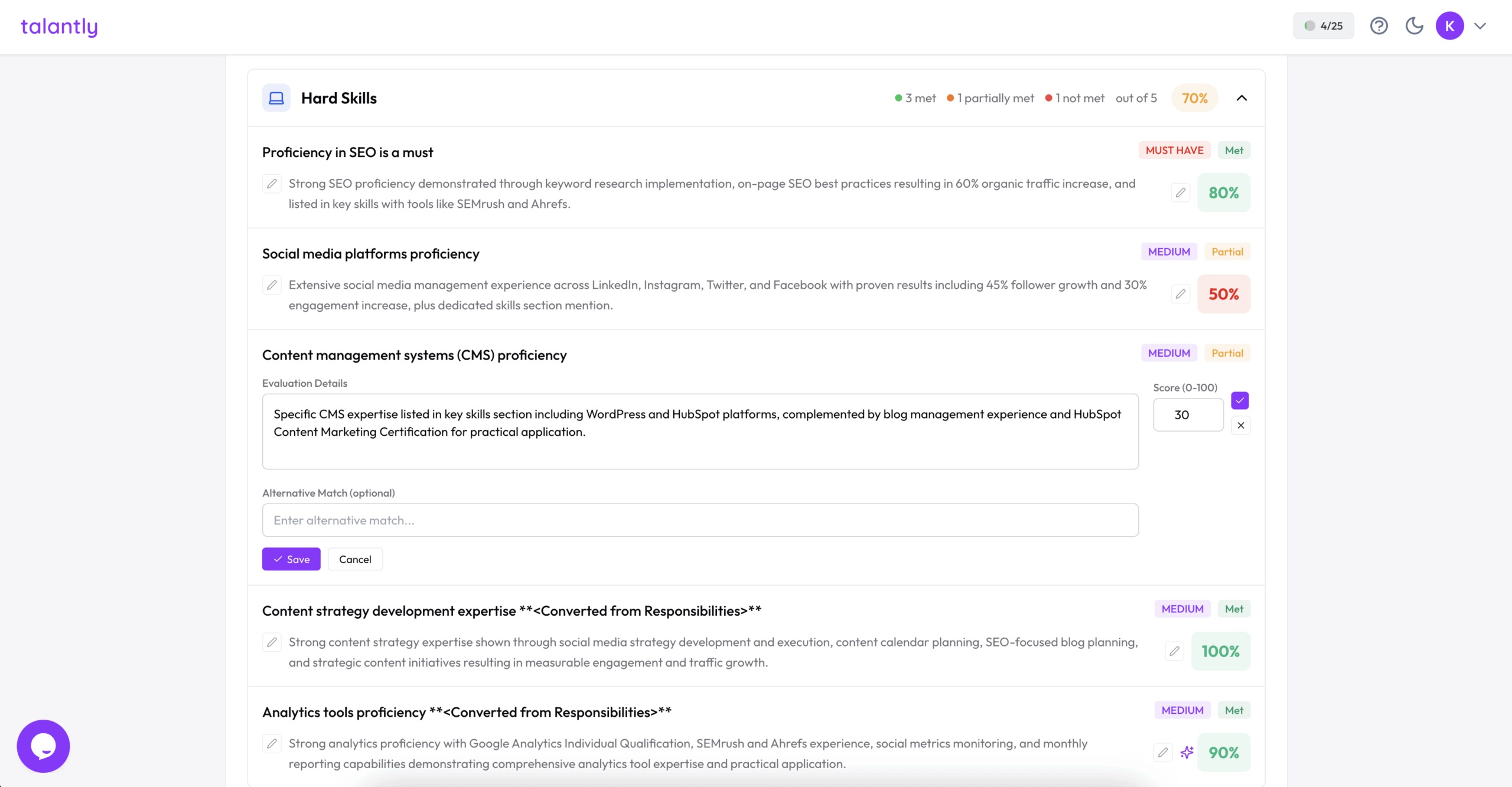To hire the right person for the job, it is crucial to understand them in every aspect. Candidate screening enables recruiters to get to know the candidate before making a critical decision: to hire or not to hire. But what is candidate screening exactly, and how should it be conducted?
Basics
Candidate screening is the process of evaluating a candidate’s fit for the job. This may include looking at hard and soft skills, education, previous work experience, cultural fit, knowledge, and many other factors, depending on the priorities set by the hiring manager.
Candidate screening is one of the first stages in hiring. It usually eliminates around 80–90% of the candidate pool, essentially picking those who will move on to manager interviews. This process is the most time-consuming of all the hiring stages, and recruiters have long tried to make it more efficient.
Today, there are different methods for screening candidates based on the role’s needs, budget, and time. Furthermore, AI candidate screening software is taking center stage, removing this process almost entirely from recruiters’ job descriptions.
So, let’s talk about how you can screen candidates.
Types of candidate screening
Experts’ views on types of candidate screening vary. On average, they define 10-12 different ways screening can be conducted. However, some are more widespread than others. Let’s discuss the 10 most common ones.
CV screening
This is the most common technique for candidate screening. Basically, a recruiter or a hiring manager parses through each resume and determines if the basic candidate skills are good enough for the job. No deeper analysis is conducted at this stage. Usually, recruiters have a set of red-line, must-have requirements they are hunting for during CV screening.
However, resume screening is not as reliable as many believe it to be, at least when used on its own. Job applicants have confessed to lying on their CVs multiple times. Additionally, bias and human error can occur, filtering out a potential candidate for the job.
Phone screening
Another type of applicant screening is phone interviews. They are not enough as a stand-alone. However, for many, it is a great way to get to know the candidate before putting them in the middle of the hiring process. A recruiter can ask questions about the main requirements and red lines, learn more about the candidate’s education, and understand the person’s attitude.
Cover Letters
Some companies require cover letters to be submitted with the job application. Generally, it is a great way to get to know a candidate’s personality efficiently. Reading through a cover letter, the recruiter will not only be able to understand the expertise but also quickly evaluate the cultural fit and soft skills.
Video screening
With the rise of remote work in 2020, video interviews have become an integral part of the hiring process. A quick call with the candidate can usually open more possibilities than it may seem. Of course, it is best combined with other screening types. However, it is one of the best ways to assess candidate’s soft and hard skills to date.
Skill Testing
Lately, more and more companies require skill testing as an integral part of their hiring process. Usually, a skill test consists of practical tasks directly related to the position. For example, coding challenges for developers, writing samples for content roles, or design tasks for creative positions. The goal is to measure actual ability rather than relying on self-reported skills in a CV.
Trial Projects
A trial project is essentially a short-term assignment given to a candidate to simulate the work they would be doing in the role. This helps the recruiter or hiring manager evaluate not only the quality of the work but also the candidate’s approach, communication, and ability to meet deadlines.
Personality screening
This type of screening focuses on evaluating traits such as leadership style, adaptability, teamwork, and stress tolerance. Such applicant assessments can reveal how a candidate might behave in different workplace scenarios and whether their style aligns with the company culture.
Background checks
Background checks verify the accuracy of a candidate’s claims about their education, employment history, and other credentials. In some industries, they also include criminal record checks, credit checks, and verification of professional licenses.
Social Media screening
Social media platforms can provide insight into a candidate’s professionalism, communication style, and potential cultural fit. However, it’s essential to use this method carefully to avoid discrimination and bias.
ATS/AI screening
Applicant Tracking Systems (ATS) and AI screening tools filter applications based on keywords, experience, and qualifications. Such systems have grown in recent years, with some ups and downs. And the latter created much controversy over whether AI candidate screening should even be considered a viable method. Nevertheless, it remains the most effective way to screen applicants.
Candidate screening in Talantly.ai
We believe that screening and evaluating candidates using AI makes the hiring process more efficient when done correctly and with human oversight. Talantly.ai does exactly that.
Talantly is an AI screening assistant that analyzes candidates’ CVs, cover letters, interview transcripts, and any other supporting documents. It creates a comprehensive overview of all the skills and evaluates their fit to the job description. One of its prominent strengths is the CV evaluation report. It turns the information into bite-sized pieces, making it easier to process. Plus, you can update candidate information as the hiring progresses.

Let’s look at the anatomy of the insights in the CV evaluation. It consists of:
- Requirement: A requirement taken from the job description.
- Assessment: If the skill is mentioned in the CV, Talantly will pull all available information about it and insert it into this field. Even if the skill appears in two different parts of the resume, AI will combine it into a single assessment.
- Alternative Match: Shown only if the skill is not present in the CV. It makes an assumption about transferable skills based on AI’s extensive knowledge of skill relationships.
- Strength: Correlates with the strength scores set in the job description. Default is “Medium,” but it can be set to “Must-Have,” “Important,” “Optional,” etc. Talantly reflects these values in its scoring.
- Total Score: An evaluation of how much the skill in the CV meets the job requirements.

Talantly allows full manual control. To change the assessment, click the left pencil icon to add, delete, or edit details, or add your own alternative match option.
If you agree with the assessment but not the score, you can change it by clicking the right pencil icon and entering the score you believe is accurate.

Important note: Scores higher than 76 are automatically set to “Met,” while anything 75 or lower is set to “Partial.” If the skill isn’t mentioned in the CV, it will remain “Not Met.”

All the changes are traceable. If a score or assessment is edited, the star badge will be removed to indicate human involvement.
Conclusion
Screening candidates is the largest and most decisive part of the hiring process. It determines the quality of the candidates you’ll move forward with, making it essential to approach it comprehensively and objectively. Traditional methods alone are no longer enough. By combining ethical AI tools like Talantly with human expertise, recruiters can streamline the process, reduce bias, and ensure they’re selecting the very best talent for every role.



